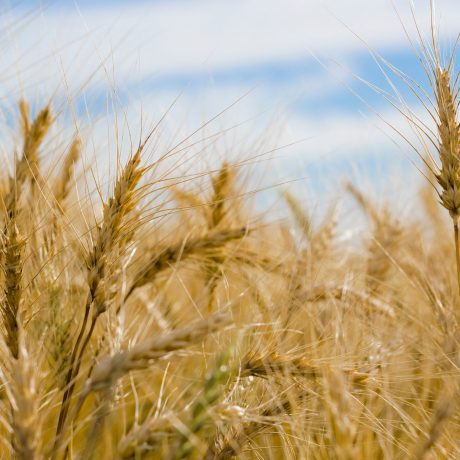Stick or Bust with Some Winter Crops after wet winter
Jock Willmott
Mar, 01 2021Winter cereals which emerged by November are generally coping with conditions quite well. Wheat crops planted in December particularly after roots are a mixed bag and very much dependent on how the fields have taken the rain. Many sections of these late planted crops will want assessing as the land dries out for redrilling.
The legacy of 2020 has afforded many with a choice of spring wheat or Skyfall seed for patching up. Spring barley is an option but is still suffering from the large discount to the new crop wheat price. Where home saving seed from an undressed parent seed source, seed testing for seedling disease is advised if considering sowing without a dressing.
There will be whole fields, headlands and patches that will require redrilling. If this can be done without an airing cultivation pass all the better, seedbed conditions may change quickly as experienced last year so be cautious of wet seedbeds drying out quickly.
While generally on top of oat volunteers in wheat and barley, barley volunteers in wheat remain an issue and wheat volunteers have continued to emerge in winter barley. Practically there is little that can be done to manage wheat volunteers in barley, growing a robust barley crop will help but it will really come down to glyphosate at harvest and storing in a separate heap if contamination is significant.
The control of both winter and spring barley volunteers in wheat is difficult to gauge while the barley is so yellow from the wet conditions. In general, where volunteer pressure was high it remains so and crops will want a spring follow up to have another go at reducing the volunteer population. This will be a balance of catching the volunteers as they start to grow (fields drain and temperatures increase) but before they get too big. “Control” is likely to be variable to potentially poor, so again be prepared at harvest. Monitor or blackgrass rates of Topik are likely to be the two least worst herbicide options but decisions will be further influenced by other grass weed pressures in the crop.
As below, nitrogen applications will be limited to land that can take the pass. For many the rape may go first, if not winter barley would be the first priority followed by the wheat. Winter barley needs biomass to yield but unlike wheat the yield potential is set early, so retention of tillers and early growth is more critical with an early maturing crop like barley hence the crop needs prioritising for application.
With wheat, the temptation is to get a dressing on the backward fields first. Practically it will be the land that travels that will get an application first. If this happens to be the forward wheat then the opportunity should be taken to do so. Much better to get some nitrogen on these crops early, reducing the rate if the crop is very big or has had an application of organic nitrogen than leaving it or getting delayed three weeks and running the risk of a dry March and or April. Late planted wheats, while needy for nitrogen, will have less yield potential so within reason prioritise the banker wheats ahead of these later crops. The opening dose of nitrogen has steadily increased over the last five years to make sure the crop has nitrogen available while there is moisture to help the crop utilise it. From mid-February onwards doses of 70 – 80kg/ha of nitrogen are not uncommon, clearly taking into consideration any contribution from organic nitrogen.
Oilseed Rape – The February Effect
Crop appearance is changing with the full green canopies of early January disappearing. Waterlogging, cold and frost have added to older leaf senescence, the crop is opening up and entering a critical period of canopy retreat.
Last year, albeit with generally smaller crops and potentially higher larvae numbers, February was a hard month on the crop. Canopy growth can only recede so far before larvae activity overpowers crop development and eventually finishes the crop off later in the spring. Keeping as much top growth on the crop is generally the only influence we can manage on farm. Keeping the pigeons off, getting some nitrogen on, and being careful with growth regulation could all help but ultimately the fields have to drain quickly and we desperately need a kind start to March.
The window for propyzamide based applications has closed, Crawler applications have until the end of February but consider the effect on the crop and possible implications if it fails on following crop options before applying.
Blackgrass control appears average due to the wet conditions but more control may come out of the mid-month frosts where roots are showing signs of taking up the herbicide.
Phoma infection is present on the leaves but we will see what is left of the crop when conditions warm up before making the final call on phoma, light leaf spot and PGR fungicide choice.
Stubborn charlock still appears to be surviving the frosts and an application of Fox may be required before the end of the month if there is a risk of the charlock interfering with the growth of the crop or the sample at harvest.
Nitrogen – applying nitrogen to frosted ground is not good practice. On farm, if the land frosts hard enough so as not to make a mess in the tramlines the crop will receive a minimum 60kg/ha dose of nitrogen this month. Whether to apply a higher rate will depend on factors including the forecast and workload. If the soil type is such that travelling is straight forward, more flexibility can be afforded with rate. Where travelling is likely to be more difficult and depending on spring workload, putting slightly more nitrogen on affords more time to return with the next pass.
Where crops are retaining canopy with low larval incidence then canopy models based on GAI can be applied.
While frosty, be careful with applications of liquid nitrogen. It is not uncommon to see yellow lines from the dribble bars in the crop when applied in frosty conditions. On its own this has minimal effect on the crop and yield but given the waterlogging and larvae numbers anything that potentially holds the crop back should be avoided if it is within our control.
Direct Drilled Cereals
September planted crops sown direct into standing cover look very well and perhaps are walking drier than crops sown into conventional seedbeds planted at the same time? Most crops sown into dry seedbeds are draining better and assuming similar field drainage, are much drier to travel on than crops planted in October/November into generally wetter soils.
October/November cereals and winter beans planted into green cover again where field drainage is maintained are not suffering unduly.
Drainage
This year has again highlighted the importance of retaining drainage maps as land is exchanged and keeping up with moling and cleaning out ditches as conditions allow.





